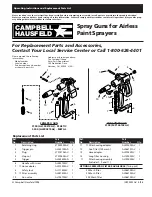
Fuel Safety
Use extreme care when handling fuel.
In certain conditions gasoline is extremely flammable
and its vapors are explosive. A fire or explosion from
gasoline can burn you, others, and cause property
damage.
•
Fill the fuel tank outdoors on level ground, in an
open area, when the engine is cold. Wipe up any
gasoline that spills.
•
Never refill the fuel tank or drain the machine
indoors or inside an enclosed trailer.
•
Do not fill the fuel tank completely full. Fill the fuel
tank to the bottom of the filler neck. The empty
space in the tank allows the gasoline to expand.
•
Never smoke when handling gasoline, and stay
away from an open flame or where gasoline fumes
may be ignited by a spark.
•
Store gasoline in an approved container and keep
it out of the reach of children.
•
Add fuel before starting the engine. Never remove
the cap of the fuel tank or add fuel when engine is
running or when the engine is hot.
•
If you spill fuel, do not attempt to start the engine.
Move away from the area of the spill and avoid
creating any source of ignition until the fuel vapors
have dissipated.
•
Do not operate the machine without the entire
exhaust system in place and in proper working
condition.
•
In certain conditions during fueling, static electricity
can be released, causing a spark, which can ignite
gasoline vapors. A fire or explosion from gasoline
can burn you and others and cause property
damage.
– Always place gasoline containers on the
ground away from your vehicle before filling.
– Do not fill gasoline containers inside a vehicle
or on a truck or trailer bed, because interior
carpets or plastic truck bed liners may insulate
the container and slow the loss of any static
charge.
– When practical, remove gasoline-powered
equipment from the truck or trailer and refuel
the equipment with its wheels on the ground.
– If this is not possible, then refuel such
equipment on a truck or trailer from a portable
container rather than from a gasoline-dispenser
nozzle.
– If you must use a gasoline-dispenser nozzle,
keep the nozzle in contact with the rim of the
fuel tank or container opening at all times
until fueling is complete. Do not use a nozzle
lock-open device.
•
Gasoline is harmful or fatal if swallowed.
Long-term exposure to vapors has caused cancer
in laboratory animals. Failure to use caution may
cause serious injury or illness.
– Avoid prolonged breathing of vapors.
– Keep your face away from the nozzle and
gasoline tank or container opening.
– Keep gasoline away from your eyes and skin.
– Never siphon gasoline by mouth.
•
To help prevent fires, do the following:
– Keep the engine and the engine area free
from accumulation of grass, leaves, excessive
grease or oil, and other debris that can
accumulate in these areas.
– Clean up oil and fuel spills and remove
fuel-soaked debris.
– Allow the machine to cool before storing the
machine in any enclosure. Do not store the
machine near a flame or any enclosed area
where open pilot lights or heat appliances are
present.
Performing Daily
Maintenance
Before starting the machine each day, perform the
following daily-check procedures:
•
Checking the Operator Presence Control (page
18)
•
Checking the Engine-Oil Level (page 54)
•
Checking the Hydraulic Fluid Level (page 69)
•
Checking the Machine for Loose Hardware (page
71)
Checking the Operator
Presence Control
Service Interval:
Before each use or daily
CAUTION
If operator presence-control switch is
disconnected or damaged the engine could
operate unexpectedly causing personal injury.
•
Do not tamper with the presence-control
switch.
•
Check the operation of the
presence-control switch daily and
replace a damaged switch before operating
the machine.
18
















































